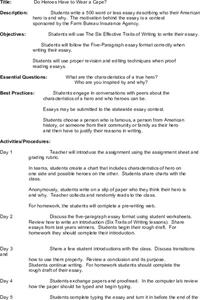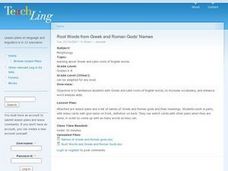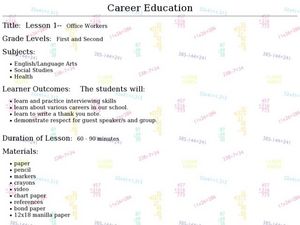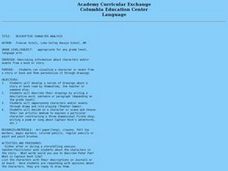Curated OER
Stories of the American Experience
Students identify a veteran to interview. This could be a family member of one of students or someone contacted through an organization in the community. They use a storyboard to plan their movie about their subject.
Curated OER
Family Portraits
Students discuss, analyze, and interpret "Portrait of a Dutch Family" by Fans Hals and then create subject specific projects for assessment. This cross-curricular lesson is well-suited for Language Arts or Visual Arts classrooms and...
Curated OER
Do Heroes Have to Wear a Cape?
Young writers choose a person from American history, their community, or their family to use as the subject of a persuasive essay. The process begins with a discussion of the characteristics of a hero, the completion of a prewriting web,...
Curated OER
Root Words from Greek and Roman Gods' Names
Prepare a stack of index cards with a Greek or Roman god's name on one side and their description on the other. Then, use the worksheet attached to brainstorm as many words that contain the root from each card. Pupils also create their...
Curated OER
Conjunction Recognition Practice
What is a coordinating conjunction, and how is it different from a correlative conjunction? First, study the three types of conjunctions. There are descriptions and examples included to help you do this. Then, release your kids for some...
Curated OER
Career Education: Office Workers
Frist and second graders explore career options. First they will watch career videos and then prepare to interview school personnel regarding their job responsibilities. They will then send thank you cards to the interviewed subjects...
Curated OER
Beary O'Mometer Learns About Careers In Meteorology
Students explore the field of meteorology. In this meteorology lesson, students explore weather-related careers as they research the field of study as well as various weather concepts. Students interview meteorologists, write business...
Curated OER
Season Sarcophagus
Students analyze a sarcophagus art and create a similar piece of art. In this sarcophagus art lesson, students investigate possible meanings of the Season Sarcophagus and create a work of art that is similar to the subject or meaning of...
Curated OER
The Evolution of the Preamble
Reading and comprehending informational text is vital in all subject areas. Upper graders use primary sources and worksheets to better comprehend the historical importance of the Preamble of the US Constitution. Web links, handouts, and...
Curated OER
Environmental Studies: The Environment Rocks!
Rock exploration, so exciting! After reading the book Everybody Needs a Rock, the class makes sandwiches to better understand that the Earth is made in layers. They then use a description of the 3 types of rock to conduct an observation...
Curated OER
Visible Speech: A Short Course in the Fundamentals of Writing
Introduce your class to various forms of writing. As the title states, this is a short PowerPoint, giving brief, but accurate descriptions of what each type of writing is used for. Pictorial representations are also helpful.
Curated OER
Other Uses for Commas
Comma usage, in direct address or in appositives, is the subject of a one-page instructional activity that begins with definitions, provides examples, and then asks learners to demonstrate their understanding in sample sentences.
Curated OER
Hummingbird Nests
Now here's a hands-on activity that little ones are sure to love. Using melted chocolate, coconut, and jelly beans they'll be able to shape tiny nests perfect for tiny birds. Kids love getting their hands dirty and the tactile experience...
Curated OER
Learning to Analyze Characters
Learners discover writing strategies authors use to enhance characters. In this character writing instructional activity, students are read the Knuffle Bunny books by Mo Willems and analyze the story, characters and settings as...
Curated OER
Descriptive Words
In this language arts worksheet, students examine 10 detailed pictures in a column. Students draw a line to match each picture with a word in another column that describes the picture. Note: All the words are not adjectives; some are...
Curated OER
What's My Rule for Sorting?
Young scholars view objects sorted by one characteristic and name that characteristic. In this sorting rule lesson, students explore to find a new characteristic and write a description of that rule. In early grades the rule...
Pennsylvania Department of Education
Properties Everywhere
Students examine and sort objects by specific attributes and apply prior knowledge. In this properties everywhere lesson, students work in groups to arrange objects in categories then discuss various sorting options while...
Curated OER
Beginning, Middle, End in Paragraph Writing
In this descriptive writing worksheet, students use the titles to each page to write a beginning, middle, and ending paragraph for each title. Students write 5 stories.
Curated OER
Noun/Adjective/Subject/Verb Agreement
Students create a wheel from construction paper to use to create sentences. The wheel consists of four concentric circles, beginning with the largest being 8 inches in diameter. Each circle represents one part of a sentence. Students...
Curated OER
Descriptive Character Analysis
Students visualize a character or event and personalize it through drawings.
Curated OER
Descriptive Drawings - Pen and Ink - Art with Text
Students create a pen and ink drawing using words to determine values choosing a work with high emotional content and incorporating words that describe the picture's content placing words together tighter, made bolder, etc. to achieve...
Curated OER
Understanding Paragraph Basics
Full of informative, helpful, and accessible activities, a language arts packet is sure to be a valuable part of your writing unit. It's versatile between reading levels and grade levels, and focuses on the most efficient ways for your...
Nancy Fetzer's Literacy Connections
Expository Paragraph
Upper elementary and middle school writers learn how to craft an expository paragraph by following the six steps detailed in a 48-page instructional guide. Learners learn how to write six different types of informational paragraphs:...
EngageNY
Inferring About Characters Based on How They Respond to Challenges (Chapter 4: "Los Higos/Figs")
How do you know what a character's personality is like if an author doesn't tell you? With a focus on character development in Esperanza Rising, pupils complete a jigsaw activity to analyze the actions of Mama, Abuelita, and Miguel. Once...

























